| Table of Contents | 1. Overview 2. Performance Indices 3. Comparison by Performance Indices ……. 3-1. Elasticity Indices ……. 3-2. Vibration Indices 4. Summary |
‘ZX-Gear’ series is a new fiber blade family launched in 2019 from Victas, which established a new C.I. and mae a completely new start by abolishing the traditional TSP brand. Differently from existing ‘Quartet’ series or ‘FireFall’ series, ‘ZX-Gear’ series is a product line produced in-house by Victas. While developing new blades, Victas wanted to use a special material that other companies did not use, and as a result, ‘Zxion’ fiber which is soft and provides sufficient elasticity was selected. (‘Zxion’ is a type of arylate fiber, but it is manufactured by a different company and has slightly different physical properties from ‘Vectran’, which is mainly used by Butterfly.) In addition to using new artificial material, Victas also developed new adhesives and bonding method used in plywood manufacturing, for creating new blades those provide unique feeling and high performance. Victas named these new blades ‘ZX-Gear’ after the name of special material ‘Zxion’. ‘ZX-Gear’ series consists of three models – ‘ZX-Gear Out’, ‘ZX-Gear In’ and ‘ZX-Gear Fiber’. Z Carbon (= Zxion Carbon) which is the mixed woven fiber of Carbon fiber and Zxion fiber is used for ‘ZX-Gear Out’ and ‘ZX-Gear, and pure woven Zxion fiber is used for ‘ZX-Gear Fiber’.
In this article, TTGearLab will analyze ‘ZX-Gear Out’ and ‘ZX-Gear In’ by Performance Indices, and for further understanding compare those two with some other blades in the market. (‘ZX-Gear Fiber’ is scheduled to be dealt with in another article.)
1. Overview
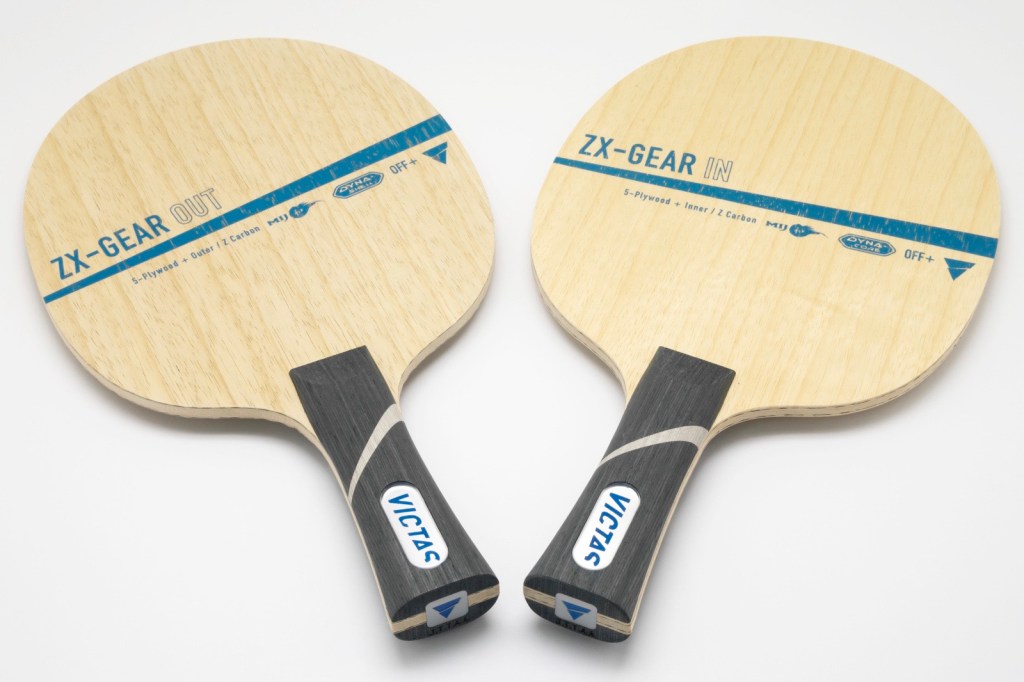
Above picture shows ‘ZX-Gear Out’ and ‘ZX-Gear In’ those are respectively outer fiber version and inner fiber version of ‘ZX-Gear’ series. Except for information such as the product name and speed level, the designs of the two blades are 100% identical, so it is difficult to distinguish between the two blades at a glance. The foreside lens with Victas logo and the ‘splitting’ character line on the foreside of head are common graphic elements those have been applied for most of Victas blades from the time of C.I. change.
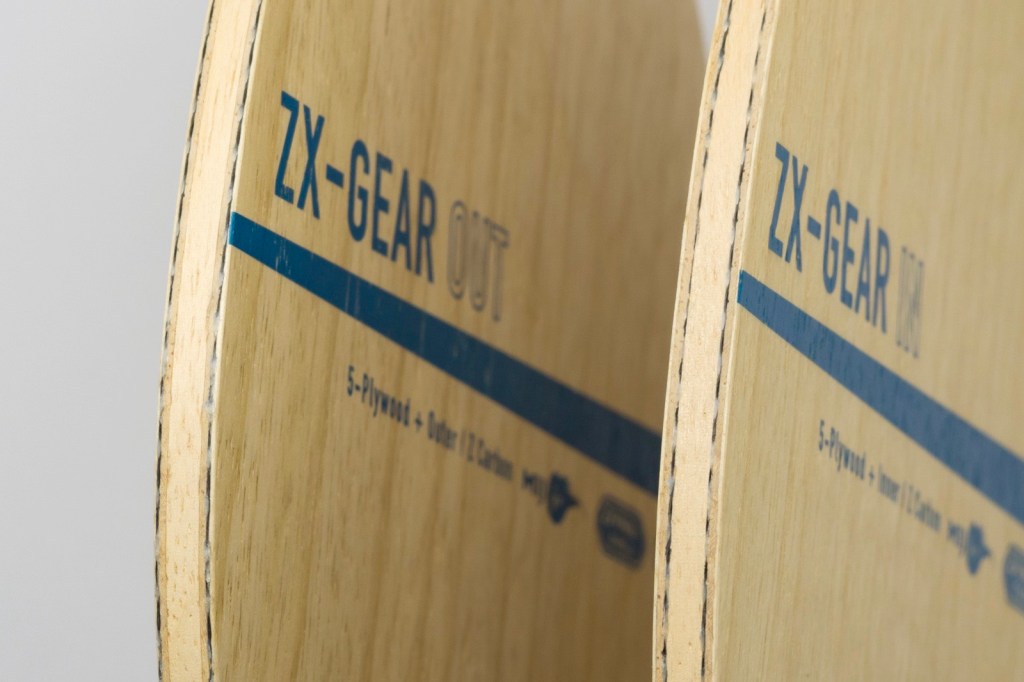
The constructions of ‘ZX-Gear Out’ and ‘ZX-Gear In’ are almost identical except for the location of artificial material – Z Carbon (= Zxion Carbon). Z Carbon is woven from Zxion fiber and Carbon fiber, and both of Zxion fiber and Carbon fiber are arranged in both of vertical direction and horizontal direction. Zxion is the brand name of LCP fiber (= Arylate fiber) produced by KB Seiren. It is a bit different from Vectran fiber which is the LCP fiber produced by Kurarei and used by Butterfly, but it is also a kind of Arylate fiber. Victas is using two kinds of ALC, but doesn’t use ALC as the name of material. Instead, Victas is calling the Arylate Carbon whose Arylate fiber is Vectran as ‘VC’, and the Arylate Carbon whose Arylate Carbon is Zxion as ‘ZC’.
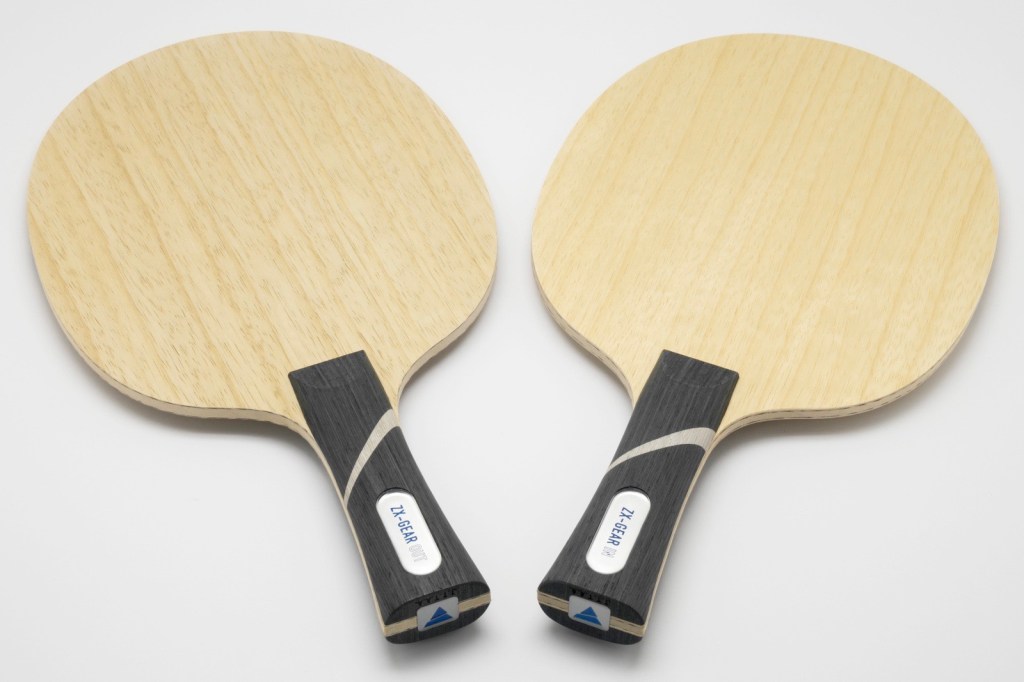
Nothing is printed on the backside of head. But, on the backside of handle there is a transparent plastic lens that indicates the name of blade. Applying lenses at both sides of handle and inserting product name in the backside lens is the common design concept of Victas.
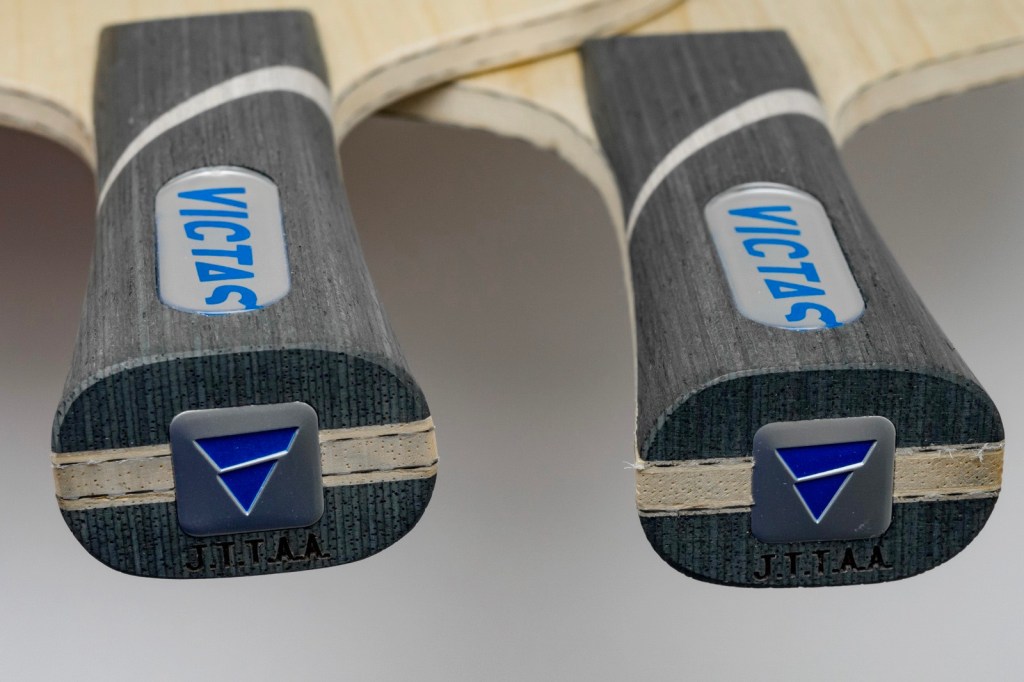
Small aluminum plate that includes engraved Victas logo mark is applied at the end of handle. This logo mark symbolizes the image of splitting V.
1-1. ZX-Gear Out (outer-fiber version)
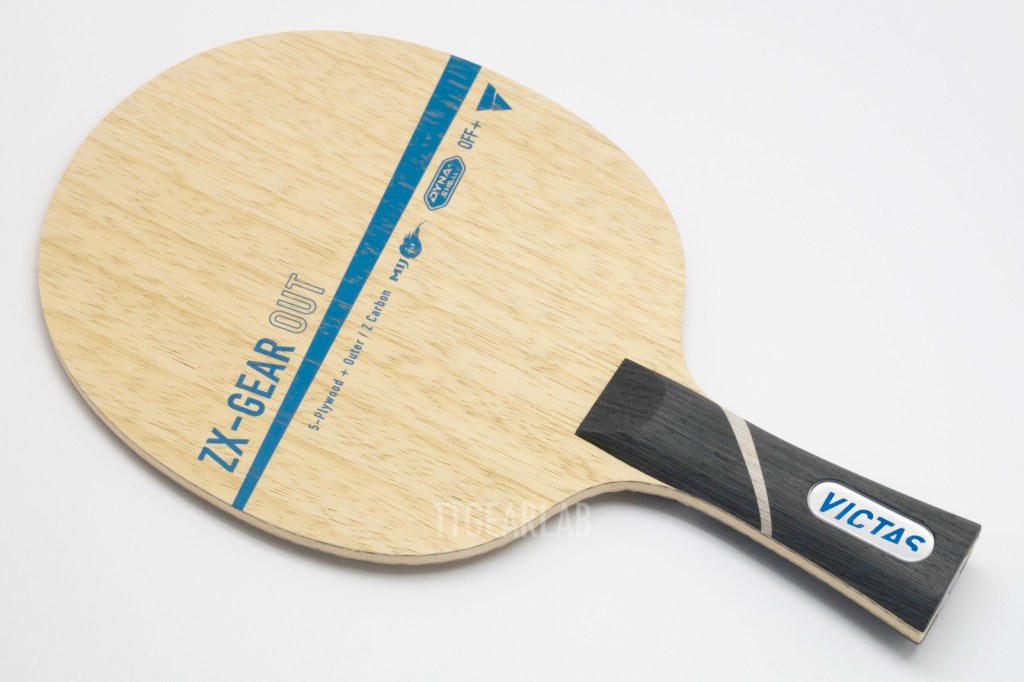
‘ZX-Gear Out’ is an outer Z Carbon model of the ‘ZX-Gear’ series, developed for the purpose of increasing the power and the stability of topspin by high elasticity and good feeling of grabbing ball. It provides higher elasticity compared to the inner fiber model – ‘ZX-Gear In’, and as the result the player can easily perform various kinds of topspin from a variety of playing areas.

Above is the blade construction of ‘ZX-Gear Out’. Z Carbon which is woven from Zxion fiber and Carbon fiber is placed directly under the top layer. The top layer is Limba. The middle layer and the center layer are Ayous. It is an unusual case that the center layer of an outer fiber blade isn’t Kiri but Ayous. Overall thickness is around 5.8mm.
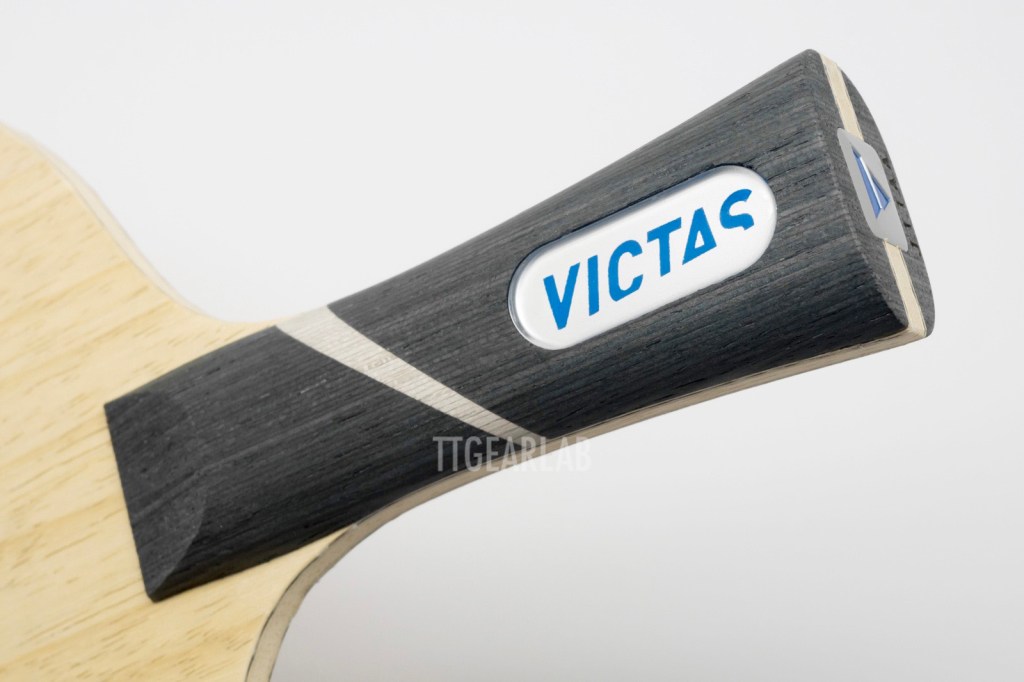
The width of FL (flared) handle of ‘ZX-Gear Out’ is around 26mm (at head side) ~ 27mm (at bulge) ~ 26mm (at narrowest point) ~ 34mm (at the end). And, the thickness of FL handle is around 22.5mm (at thumb) ~ 23.5mm (at the end). The FL handle isn’t a wide handle, and it is somewhat thinner than ordinary FL handles. But, the stability of grip is good because the surfaces are relatively flat.
The size of ST (straight) handle of ‘ZX-Gear Out’ is around 28mm (width) x 22mm (thickness). Its surfaces are also relatively flat, but not completely flat as the ST handles of ‘Firefall’ series.

The head size of ‘ZX-Gear Out’ is around 157mm x 150mm.
1-2. ZX-Gear In (inner-fiber version)

‘ZX-Gear In’ is an inner Z Carbon model of the ‘ZX-Gear’ series, focusing on the convenience of on table techniques and the power of the topspin. It provides relatively high elasticity as an inner fiber blade, so it can be used for a variety of playing styles. But, the most efficient style that can bring out its full potential is the aggressive topspin that aims at the early timing of rising of the ball.
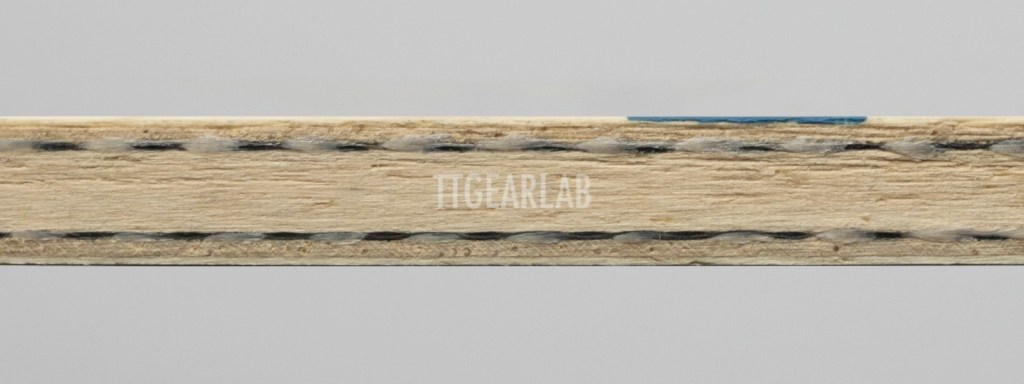
Above is the blade construction of ‘ZX-Gear In’. Z Carbon which is woven from Zxion fiber and Carbon fiber is placed between the middle layer and the center layer. The top layer is Limba. The middle layer and the center layer are Ayous. Overall thickness is around 5.9mm.
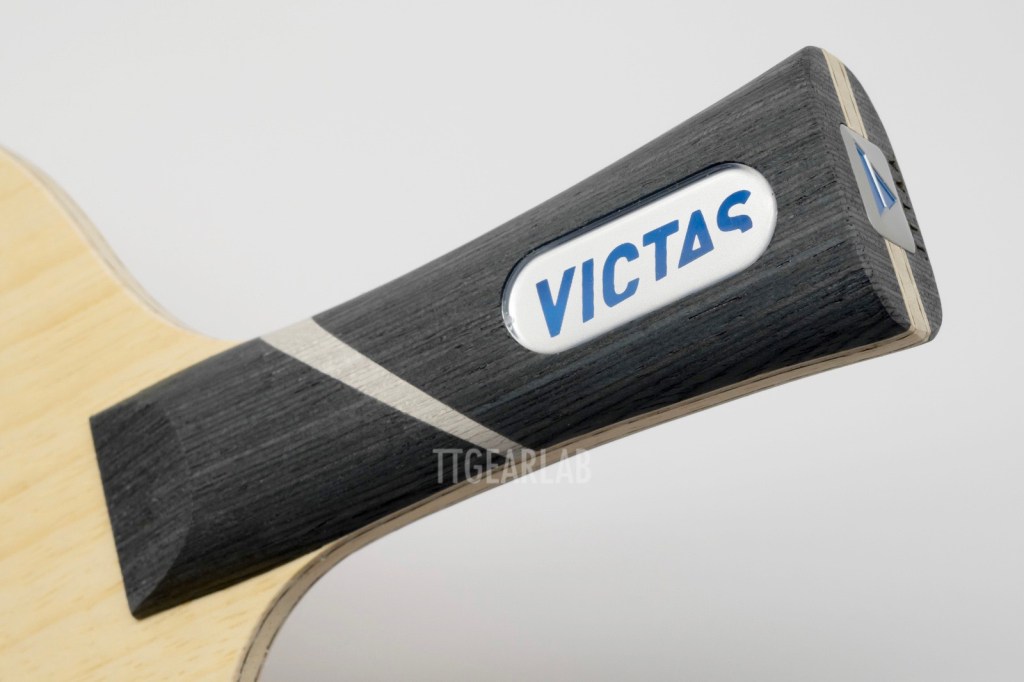
The width of FL (flared) handle of ‘ZX-Gear In’ is around 26mm (at head side) ~ 27mm (at bulge) ~ 26mm (at narrowest point) ~ 34mm (at the end). And, the thickness of FL handle is around 22.5mm (at thumb) ~ 23.5mm (at the end). The FL handle isn’t a wide handle, and it is somewhat thinner than ordinary FL handles. But, the stability of grip is good because the surfaces are relatively flat.
The size of ST (straight) handle of ‘ZX-Gear In’ is around 28mm (width) x 22mm (thickness). Its surfaces are also relatively flat, but not completely flat as the ST handles of ‘Firefall’ series.
There isn’t any difference in shape and size of handles between ‘ZX-Gear Out’ and ‘ZX-Gear In’.
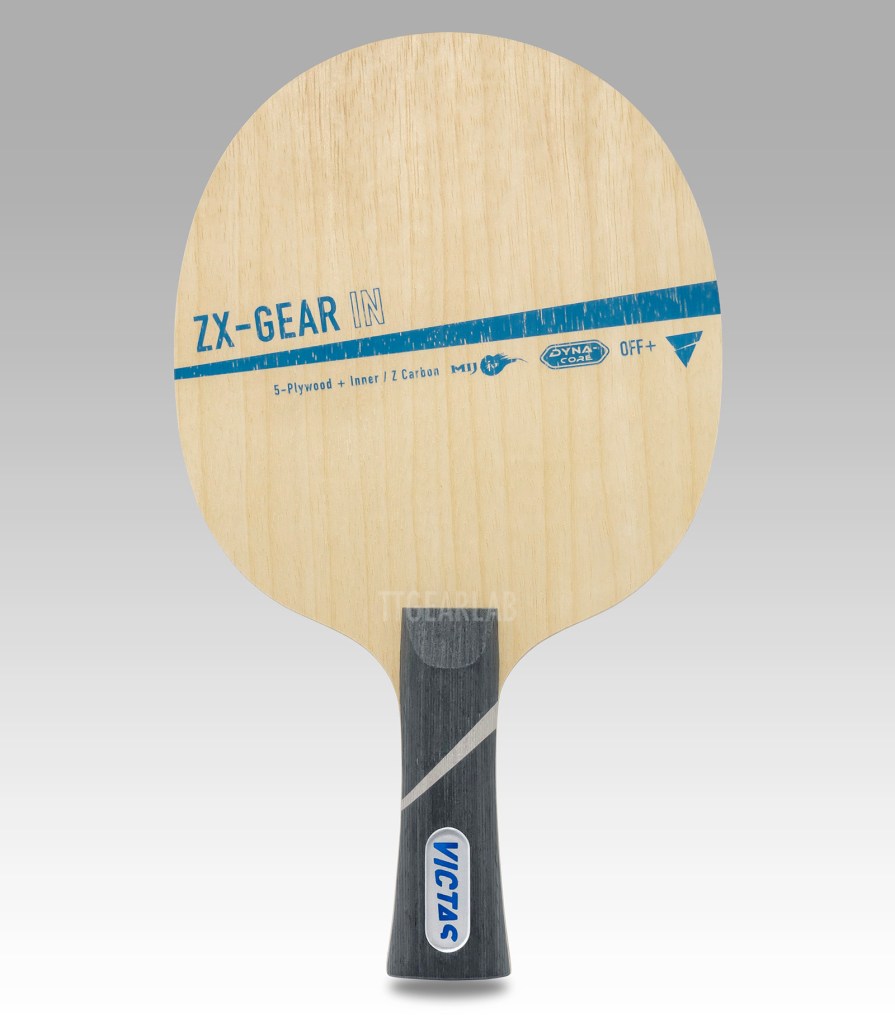
The head size of ‘ZX-Gear In’ is around 157mm x 150mm. Some table tennis makers are applying different head sizes for outer fiber model and inner fiber model. But, Victas doesn’t do that and is unifying the head size within the blade family.
The head size of ‘ZX-Gear In’ is around 157mm x 150mm. Some table tennis makers are applying different head sizes for outer fiber model and inner fiber model. But, Victas doesn’t do that and is unifying the head size within the blade family.
Please click here to return to top (table of contents)
2. Performance Indices
Performance Indices are measured objective values to represent the characteristics of table tennis gears. Concerning the detail of four performance indices, please refer to following articles in ‘About TTGearLab’ section :
- Performance indices : the way to evaluate blade by measurement
- The example of comparison by performance indices
The performance indices of ‘ZX-Gear Out’ and ZX-Gear In’ are as follows:
Victas ZX-Gear Out (average weight = 87.1g)
Ep = 1.97
Ec = 1.59 (Ec/Ep = 0.80)
Vp = 1.20
Vl = 1.40 (Vl/Vp = 1.16)
Victas ZX-Gear In (average weight = 88.0g)
Ep = 1.83
Ec = 1.42 (Ec/Ep = 0.78)
Vp = 1.13
Vl = 1.31 (Vl/Vp = 1.16)
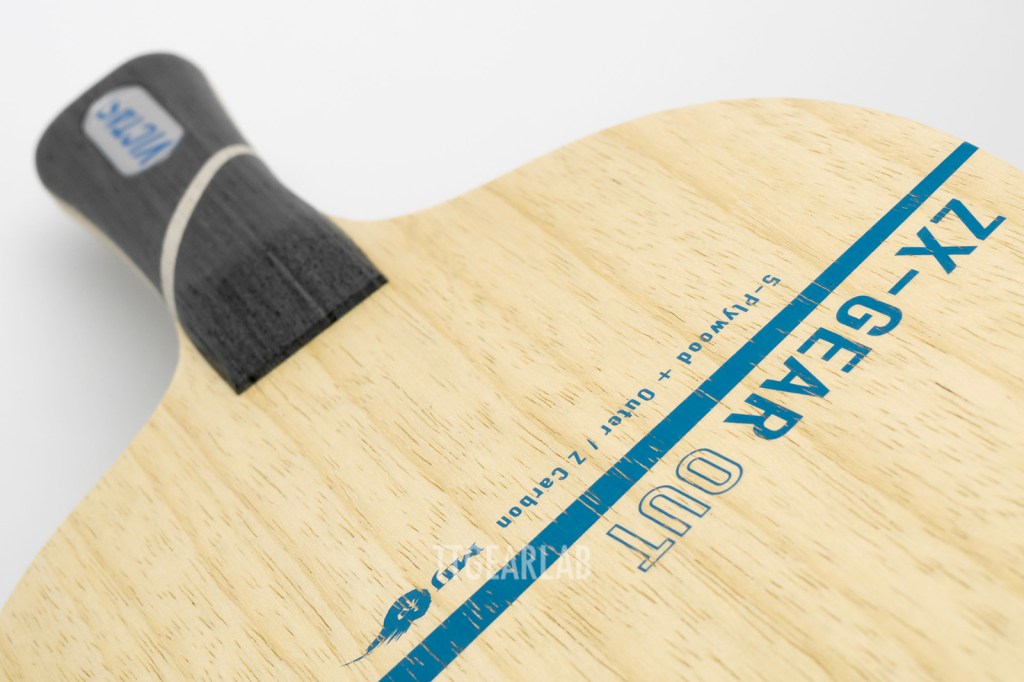
‘ZX-Gear Out’ is the outer-fiber version of this series. It is very elastic blade, although its Ep (= 1.97) doesn’t exceed 2.0 that can be considered as the criteria of fast blade. Its Ec (= 1.59) is astonishingly lower than its Ep, and therefore its Ec/Ep is just 0.80. It is expected that ‘ZX-Gear Out’ is a fast blade but it hugs ball very deeply when the player hits the ball very strongly.
Regarding Vibration Indices, the Vp of ‘ZX-Gear Out’ is 1.20, and it is somewhat lower than what we can expect from outer ALC blades. Many players will feel that ‘ZX-Gear Out’ is softer than expected from its construction. But, its Vl (= 1.40) is a bit higher than what we can expect from outer ALC blade (= around 1.30~1.35). Because its Vl is much higher than its Vp, the Vl/Vp of ‘ZX-Gear Out’ is quite high (= 1.16). It means that the feeling transferred to the player’s index finger is much sharper than the primary feeling.
The relative values (Ec/Ep and Vl/Vp) of ‘ZX-Gear Out’ remind us of those of ‘Korbel’ and some Stiga fiber blades. We will observe it by graph in next chapter.
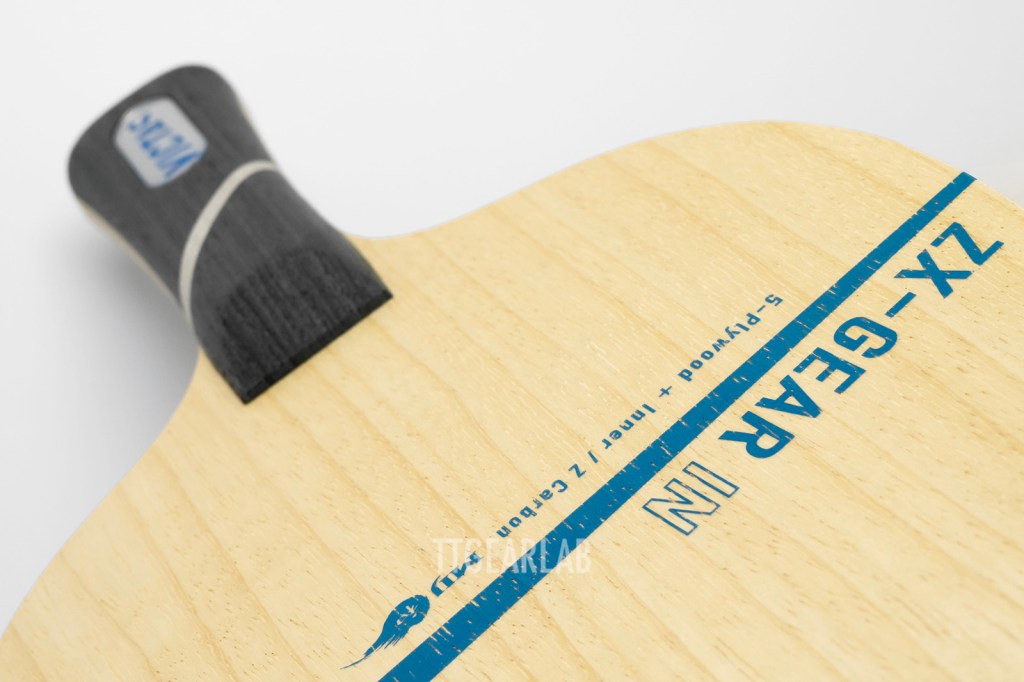
‘ZX-Gear In’ is the inner-fiber version of this series. Its Ep (= 1.83) is what we can expect from inner ALC blade whose thickness is 5.9~6.0mm. But, its Ec (= 1.42) is much lower than its Ep, and is much lower than what we can expect from thick inner ALC blades. As a result its Ec/Ep (= 0.78) is even under 0.80. It is an extremely low value. It is expected that ‘ZX-Gear In’ hugs ball extremely deep when the player hits the ball very strongly.
Regarding Vibration Indices, the Vp of ‘ZX-Gear In’ is 1.13. It is lower value than those of ordinary inner ALC blades. But, its Vl (= 1.31) isn’t that low. As the result, its Vl/Vp (= 1.16) is quite high. It means that the feeling transferred to the player’s index finger is much sharper than the primary feeling.
Like ‘ZX-Gear Out’, the relative values (Ec/Ep and Vl/Vp) of ‘ZX-Gear In’ also remind us of those of ‘Korbel’ and some Stiga fiber blades. We will observe it by graph in next chapter.
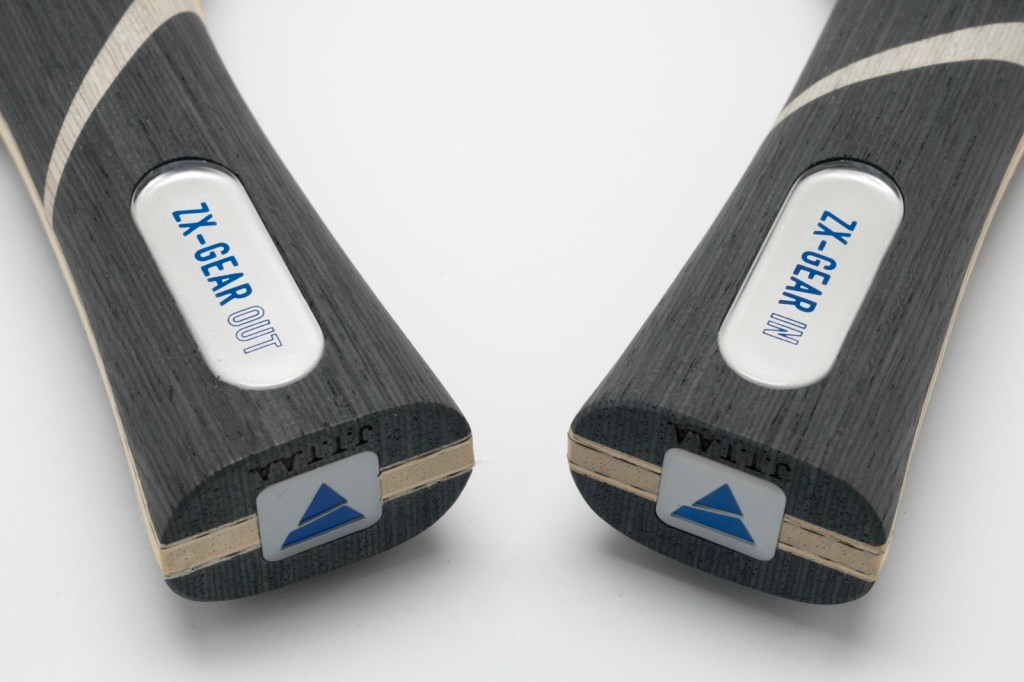
From the Performance Indices, we can see that ‘ZX-Gear Out’ and ‘ZX-Gear In’ share overall characteristics. The differences between two blades are that ‘ZX-Gear Out’ is a bit more elastic & a bit harder while ‘ZX-Gear In’ is a bit less elastic & a bit softer. Both of those two seems to be quite different from Butterfly blades, and close to Stiga blades. We will compare those two with Butterfly blades and Stiga blades by graphs in next Chapter.
Please click here to return to top (table of contents)
3. Comparison by Performance Indices
Then we can compare ‘ZX-Gear Out’ and ZX-Gear In’ with some other blades. For the comparison some well-known outer-fiber blades and inner-fiber blades have been selected.
Following is the list of the blades to be compared :
Outer ALC blades of Butterfly
- Butterfly ‘Freitas ALC’ (avg. weight = 87.4g) : Outer ALC blade with Limba top layer. Because of its top layer, it can be directly compared with ‘ZX-Gear Out’.
- Butterfly ‘Viscaria’ (avg. weight = 87.1g) : Outer ALC blade with Koto top layer. Current version.
Outer Carbon blades of Stiga
- Stiga ‘Dynasty Carbon’ (avg. weight = 89.9g) : Outer Mid-density TeXtreme blade with Koto top layer.
- Stiga ‘Carbonado 145’ (avg. weight = 88.0g) : Outer Mid-density TeXtreme blade with Limba top layer. TeXtreme is arranged in rotated direction by 45 degree.
- Stiga ‘Carbonado 190’ (avg. weight = 90.8g) : Outer Mid-density TeXtreme blade with Limba top layer. TeXtreme is arranged in ordinary direction.
- Stiga ‘Legacy Carbon’ (avg. weight = 83.0g) : Outer 12K Carbon blade with Limba top layer.
Inner ALC blades
- Butterfly ‘Ovtcharov InnerForce ALC’ (avg. weight = 88.0g) : Thick inner-ALC blade. Faster than most of inner fiber blades.
- Butterfly ‘InnerForce Layer ALC’ (avg. weight = 91.2g) : The standard of inner-ALC blades. Current version measured in 2023. Thicker and more elastic than former ones measured in 2018. It can be directly compared with ‘ZX-Gear In’.
- DHS New ‘Hurricane Long 5’ (avg.weight = 88.1g) : Representative of current inner-ALC blades – New 2022 version.
- Xiom ‘36.5 ALXi’ (avg. weight = 87.1g) : Similar to older ‘InnerForce Layer ALC’ measured in 2018.
5-ply Wood
- Butterfly ‘Korbel’ (avg. weight = 88.7g) : The standard of 5-ply wood offensive blades
3-1. Elasticity Indices
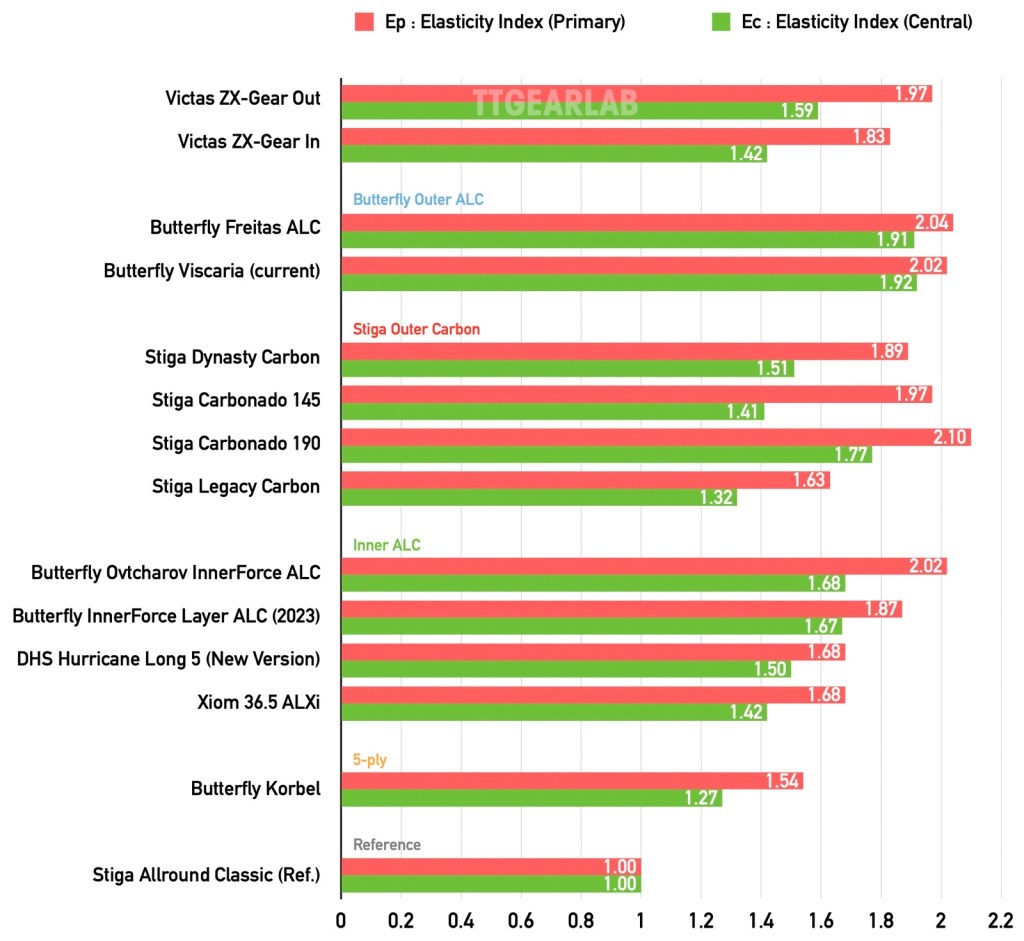
Fig.16 shows the comparison graph of Elasticity Indices.
Ep (Primary Elasticity Index) is directly concerned with the rebound speed of blade. Ec (Central Elasticity Index) is concerned with additional ‘kick’ when player hits ball very strongly.
We can see that ‘ZX-Gear Out’ is more elastic than ‘ZX-Gear In’. It is a matter of course because the wider the gap between artificial fiber the higher the elasticity. And further, the graph shapes of those two look very similar to each other. It means that the two models of ‘ZX-Gear’ behaves in the similar way and are distinguished just by elasticity level. So, when the player select between those two models, the criteria isn’t the kind of construction (= outer or inner) but just the elasticity level.
Then, let’s compare other blades by group with two models ‘ZX-Gear’ series.
[Butterfly Outer ALC] The two blades in this group can be mainly compared first with ‘ZX-Gear Out’. The blade in this group that can be directly compared with ‘ZX-Gear Out’ is ‘Freitas ALC’ because its top layer is Limba. But, there isn’t noticeable differences in Elasticity Indices between ‘Freitas ALC’ and ‘Viscaria’. (‘Viscaria’ provides same level of elasticity by thinner construction than ‘Freitas ALC’ thanks to its harder top layer.) The Ep of ‘Freitas ALC’ is higher than that of ‘ZX-Gear Out’, but the difference is small. On the contrary, the Ec of ‘Freitas ALC’ is much higher than that of ‘ZX-Gear Out’. The fact that the Ec is much lower compared to the Ep is a characteristic of ‘ZX-Gear’ series that distinguishes it from Butterfly blades. ‘ZX-Gear Out’ hugs the ball much deeper than ‘Freitas ALC’ or ‘Viscaria’ when the player hits the ball very strongly. Some players will feel that ‘ZX-Gear Out’ is much softer and slower than two Butterfly outer ALC blades.
[Stiga Outer Carbon] The outer carbon blades of Stiga tend to hug the ball very deep while providing softer feeling. We can find a commonality between ‘ZX-Gear’ series and Stiga outer carbon blades in that the gap between Ep and Ec is very large. ‘Dynasty Carbon’ is less elastic than ‘ZX-Gear Out’, but the differences are not significant. The graph shape of ‘Dynasty Carbon’ looks very similar to that of ‘ZX-Gear Out’. ‘Carbonado 145’ shows the Ep close to that of ‘ZX-Gear Out’ and the Ec close to that of ‘ZX-Gear In’. ‘Carbonado 145’ has unique characteristics because the direction of arrangement of its fiber is rotated by 45 degrees. On the other hand, ‘Carbonado 190’ shows more general characteristics, but still the gap between its Ep and its Ec is large. The Ep and the Ec of ‘Carbonado 190’ is respectively higher and lower than those of Butterfly outer ALC blades. When compared with ‘ZX-Gear Out’, both of the Ep and the Ec of ‘Carbonado 190’ are higher. On the contrary, ‘Legacy Carbon’ shows Ep and Ec even lower than those of ‘ZX-Gear In’.
[Inner ALC] Inner ALC blades can be mainly compared with ‘ZX-Gear In’. The blades in this group those can be directly compared with ‘ZX-Gear In’ are ‘Ovtcharov InnerForce ALC’ and ‘InnerForce Layer ALC’, but both of those two shows higher elasticity level than ‘ZX-Gear In’. The Ep and the Ec of ‘Ovtcharov InnerForce ALC’ are even higher than those of ‘ZX-Gear Out’. The Ep of ‘InnerForce Layer ALC’ is just a bit higher than the Ep of ‘ZX-Gear In’, but there is much bigger difference in Ec. When the player hits the ball very strongly, ‘ZX-Gear In’ hugs the ball much deeper than ‘InnerForce Layer ALC’. Because ‘InnerForce Layer ALC’ gives much stronger kick in that situation, many players will feel that ‘ZX-Gear In’ is a slower and softer blade than ‘InnerForce Layer ALC’. And, even ‘Hurricane Long 5’ or ‘36.5 ALXi’ whose Ep’s are much lower than that of ‘ZX-Gear In’ shows Ec’s a bit higher than or same as the Ec of ‘ZX-Gear In’. We can understand that the Ec of ‘ZX-Gear In’ is extraordinarily low.
[5-ply wood] The graph shape of ‘Korbel’ looks similar to the graph shapes of ‘ZX-Gear In’ and ‘ZX-Gear Out’. If the player wants to increase the elasticity level from ‘Korbel’ while keeping overall characteristics, ‘ZX-Gear In’ may be very good choice. And, ‘ZX-Gear Out’ will be the choice in case the player wants to go one step further.
Examining Ec/Ep is an easier way to understand the characteristics of blade concerned with elasticity. Fig.17 shows the relationship between Ec/Ep and Ep.

Ec/Ep expresses the ‘tendency’ of the elasticity of blade. By examining Ec/Ep and Ep at the same time, we can easily understand the behavior of blades.
On the graph, all blades in this comparison (except for reference blade whose Ec/Ep = 1.00) are in ‘Hold’ range (Ec/Ep < 1.0). But, the blades are widely distributed up, down, left and right within that range.
We can observe that both of ‘ZX-Gear Out’ and ‘ZX-Gear In’ are in ‘Deep Hold’ range. And further, the position of those two are close to center of the location of ‘Stiga Outer Carbon’ group.
[Butterfly Outer ALC] The two blades in this group is in ‘Mild Hold’ range. Those two are basically more elastic and give noticeably stronger kick when compared with ‘ZX-Gear’ series. The characteristics of ‘Freitas ALC’ and ‘Viscaria’ are totally different from the characteristics of ‘ZX-Gear Out’ (and ‘ZX-Gear In’).
[Stiga Outer Carbon] The locations of two ‘ZX-Gear’ models are within the area of this group. It means that the elasticity characteristics of ‘ZX-Gear’ series are similar to those of Stiga outer carbon blades. Especially ‘Dynasty Carbon’ is located between ‘ZX-Gear In’ and ‘ZX-Gear Out’ very closely. Although the top and the fiber of Dynasty Carbon (Koto & TeXtreme) are different from those of ‘ZX-Gear’ series (Limba & Z Carbon), we can understand that its elasticity characteristics are very similar to those of ‘ZX-Gear’ series. And, it is interesting that five blades – ‘ZX-Gear In’, ‘Dynasty Carbon’, ‘ZX-Gear Out’, ‘Ovtcharov InnerForce ALC’ of different group and ‘Carbonado 190’ – are almost on one straight line shown in light red color. When players want to adjust the elasticity characteristics of blade among those five models, they can go up right or down left on this straight line. ‘Carbonado 145’ is not on that line but at much lower position. Although the Ep of ‘Carbonado 145’ is similar to that of ‘ZX-Gear Out’, it hugs the ball much deeper than ‘ZX-Gear Out’ when the player hits the ball very strongly. On the other hand, ‘Legacy Carbon’ hugs the ball as deeply as ‘ZX-Gear In’ or ‘ZX-Gear Out’ does, but its basic elasticity is much lower.
[Inner ALC] Inner ALC blades are also in Deep Hold range, but the position of this group is not as low as the positions of ‘ZX-Gear In’ and ‘ZX-Gear Out’. The closest one to ‘ZX-Gear’ series is ‘Ovtcharov InnerForce ALC’ that is on the red straight line in the range of Stiga Outer Carbon group. Probably many players will feel that the elasticity characteristics of ‘Ovtcharov InnerForce ALC’ is not much different from that of ‘ZX-Gear Out’. On the other hand, ‘InnerForce Layer ALC’ is above two ‘ZX-Gear’ blades. ‘InnerForce Layer ALC’ also hugs the ball very deeply, but not as deeply as ‘ZX-Gear’ blades. There will be many players who feel that ‘InnerForce Layer ALC’ is much faster than ‘ZX-Gear In’ and even faster than ‘ZX-Gear Out’. ‘Hurricane Long 5 and ‘36.5 ALXi’ are less elastic than ‘ZX-Gear In’ in primary elasticity, but gives much more additional kick than ‘ZX-Gear In’. For that reason some players will feel that ‘Hurricane Long 5 and ‘36.5 ALXi’ are faster than ‘ZX-Gear In’.
[5-ply wood] ‘Korbel’ is located to lower left of Inner ALC group. It hugs the ball as deep as ‘ZX-Gear Out’ or ‘Ovtcharov InnerForce ALC’ does. In case the player who have used ‘Korbel’ requires higher elasticity but at the same time want to keep the Deep Hold character of ‘Korbel’, five blade on the red straight line – ‘ZX-Gear In’, ‘Dynasty Carbon’, ‘ZX-Gear Out’, ‘Ovtcharov InnerForce ALC’ and ‘Carbonado 190’ – are worth considering. The player will be able to fine-tune among five blades. And, if the player want to adjust just a little, ‘Legacy Carbon’ will be more proper choice than those five. Then next, let’s compare Vibration Indices.
Please click here to return to top (table of contents)
3-2. Vibration Indices
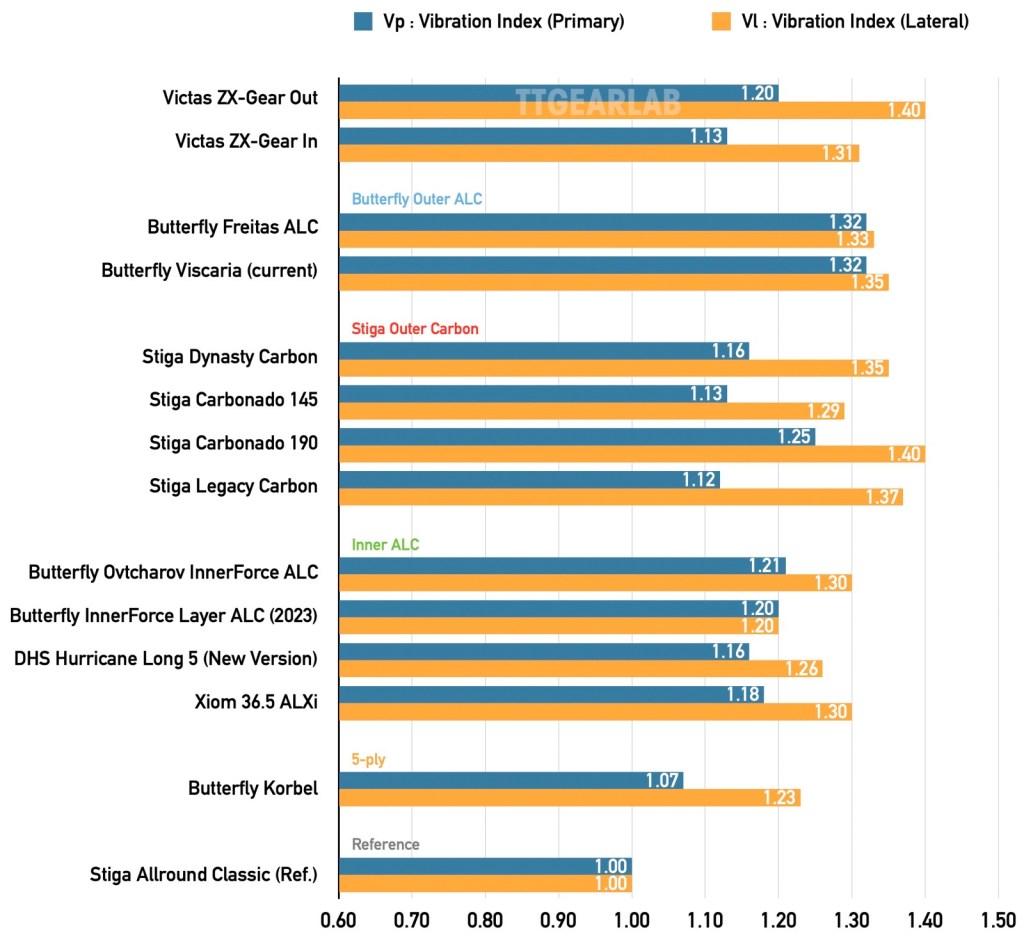
Fig.18 shows the comparison graph of Vibration Indices. Vibration Indices are concerned with feeling. The bigger the value the harder the feeling. Vp indicates primary feeling which is transferred to player’s palm. And, Vl is the feeling at the edge of the wing – the lower side of blade head. It is felt by player’s index finger or middle finger.
We can see that the graph shape of of ‘ZX-Gear Out’ and ‘ZX-Gear In’ are similar to each other. The values of ‘ZX-Gear Out’ are higher than those of ‘ZX-Gear In’, and for both of two models Vl is much higher than Vp. So we can think that ‘ZX-Gear Out’ and ‘ZX-Gear In’ are the variations those share the basic characteristics.
Then, let’s compare other blades by group with two models ‘ZX-Gear’ series.
[Butterfly Outer ALC] The two blades in this group can be mainly compared with ‘ZX-Gear Out’ because of their constructions, but the graph shapes of those two are totally different from the graph shapes of ‘ZX-Gear Out’ (and also ‘ZX-Gear In’). Because of higher Vp and lower Vl, ‘Freitas ALC’ and ‘Viscaria’ are harder than ‘ZX-Gear Out’ in primary feeling but transmits softer feeling to the index finger of the player. Players will feel a lot of difference when switching from two Butterfly outer ALC to ‘ZX-Gear Out’ and vice versa.
[Stiga Outer Carbon] Differently from Butterfly outer ALC blades, Stiga outer carbon blades show similar graph shapes as those of ‘ZX-Gear’ blades. As we did in the observation of elasticity indices, again we can find a commonality between the vibration indices of ‘ZX-Gear’ series and those of Stiga outer carbon blades. ‘ZX-Gear Out’ and ‘ZX-Gear In’ gives similar feeling as Stiga outer carbon blades. Especially indices of ‘Dynasty Carbon’ are close to those of ‘ZX-Gear Out’, and the indices of ‘Carbonado 145’ close to those of ‘ZX-Gear In’. ‘Carbonado 190’ shows somewhat higher value of Vp than ‘ZX-Gear Out’, but its graph shape is still quite similar to those of ‘ZX-Gear’ series. The graph shape of ‘Legacy Carbon’ is also quite similar to that of ‘ZX-Gear In’.
[Inner ALC] Inner ALC blades can be mainly compared with ‘ZX-Gear In’. But, the graph shapes of the blades in this group look somewhat different from those of ‘ZX-Gear In’ or ‘ZX-Gear Out’. The gap between Vl and Vp of the blades in this group is not as big as we can see from ‘ZX-Gear’ series. ‘Ovtcharov InnerForce ALC’ shows the Vp similar to that of ‘ZX-Gear Out’ and the Vl similar to that of ‘ZX-Gear In’. The Vp of ‘InnerForce Layer ALC’ is same as that of ‘ZX-Gear Out’, but the graph shape of ‘InnerForce Layer ALC’ is totally different from those of two ‘ZX-Gear’ models. ‘Hurricane Long 5’ and ‘36.5 ALXi’ show higher Vp’s and lower Vl’s when compared with ‘ZX-Gear In’. Except for ‘InnerForce Layer ALC’,
[5-ply wood] ‘Korbel’ shows very similar graph shape as those of two ‘ZX-Gear’ blades, although overall values are one step lower than those of ‘ZX-Gear In’. As we did in the observation of elasticity indices, again we can find a commonality between the vibration indices of ‘ZX-Gear’ series and those of ‘Korbel’ which is a 5-ply wood offensive blade.
Examining Vl/Vp is an easier way for the comparison of the tendency of feeling. Fig.19 shows the relationship between Vl/Vp and Vp for easier comparison.

On the graph, most of blade in this comparison are placed in upper part of the graph – ‘Relatively sharper at finger’ range. And, two including reference blade are on uniform line.
We can observe that both of ‘ZX-Gear Out’ and ‘ZX-Gear In’ are in ‘Relatively sharper at finger’ range. And, positions of ‘ZX-Gear Out’ and ‘ZX-Gear In’ are in the area of Stiga Outer Carbon group.
[Butterfly Outer ALC] This group is located to lower right of ‘ZX-Gear Out’, and the distance between this group and ‘ZX-Gear Out’ is quite large. When compared with ‘ZX-Gear Out’, the two blades in this group are much harder in primary feeling but transmits much less comfortable feeling to index finger. ‘Freitas ALC’ and ‘Viscaria’ are totally different from ‘ZX-Gear Out’ not only in elasticity but also in feeling. Therefore, the change between those Butterfly outer ALC blades and ‘ZX-Gear’ models isn’t recommended unless the player has a compelling reason to do so.
[Stiga Outer Carbon] Two ‘ZX-Gear’ blades are located in the arear of this group. Especially ‘Legacy Carbon’ and ‘Carbonado 145’ are close to ‘ZX-Gear In’. ‘Dynasty Carbon’ is located between ‘ZX-Gear In’ and ‘ZX-Gear Out’. It is harder than ‘ZX-Gear In’ and softer than ‘ZX-Gear Out’ in primary feeling, but its level of relative feeling is same as those of two ‘ZX-Gear’ models. ‘Carbonado 190’ is located to lower right of ‘ZX-Gear Out’, but is still in ‘Relatively Sharper at Finger’ range’ (Vl/Vp > 1.10). It is somewhat harder in primary feeling and less sharp at finger when compared with ‘ZX-Gear Out’, but still comparable with ‘ZX-Gear Out’. All blades in this group and two ‘ZX-Gear’ show similar level of Vl/Vp as ‘Korbel’ which is a 5-ply wood offensive blade. So those can be proper blades when the player wants to replace ‘Korbel’ with faster/harder blade. It is interesting that ‘ZX-Gear’ blades those are made in Japan show similar characteristics to Stiga Carbon blades made in Sweden. It may be thanks to new wood production process of Victas or because of the property of Z-Carbon.
[Inner ALC] The position of Inner ALC group is below the position of Stiga Outer Carbon group. So the blades in this group transmit less sharp feeling than ‘ZX-Gear’ blades and the blades in Stiga Outer Carbon group. But, many players will feel that three blades – ‘Hurricane Long 5’, ‘36.5 ALXi’ and ‘Ovtcharov InnerForce ALC’ – are sufficiently sharp. On the other hand, ‘InnerForce Layer ALC’ transmits the feeling that isn’t sharper or softer than primary feeling to index finger. The player who has used ‘InnerForce Layer ALC’ will feel that ‘ZX-Gear In’ transmits much sharper feeling to index finger while giving much softer primary feeling. Because ‘ZX-Gear In’ is totally different from ‘InnerForce Layer ALC’, the change between those two isn’t recommendable unless the player want to greatly adjust the property of blade to upper left side.
[5-ply wood] The Vl/Vp of ‘Korbel’ is at the same level as Stiga Outer Carbon group (and two ‘ZX-Gear’ models). For that reason, when the player wants to change from ‘Korbel’, ‘ZX-Gear In’ or ‘ZX-Gear Out’ are also good choices not only in terms of elasticity but also in terms of feeling. Although the primary feeling will become harder, the player will not experience much trouble.
Please click here to return to top (table of contents)
4. Summary
Victas ‘ZX-Gear’ series is a new fiber blade family that represents the blade range of Victas which completely liquidated its past brand – TSP – and even changed its CI to pursue a new brand image. Unlike existing Victas blades, ‘ZX-Gear’ series are blades manufactured by Victas in-house. New ‘Z Carbon’ which is woven from Zxion, a type of arylate fiber, and carbon fiber is used as the artificial material of ‘ZX-Gear Out’ and ‘ZX-Gear In’. (And, woven Zxion fiber that doesn’t include carbon fiber is used for another model – ‘ZX-Gear Fiber’.) Victas is improving the feeling and the energy efficiency of ‘ZX-Gear’ series by improving the manufacturing process. The characteristics of ‘ZX-Gear Out’ which is outer Z carbon version and ‘ZX-Gear In’ which is inner Z carbon version in the series can be summarized as :
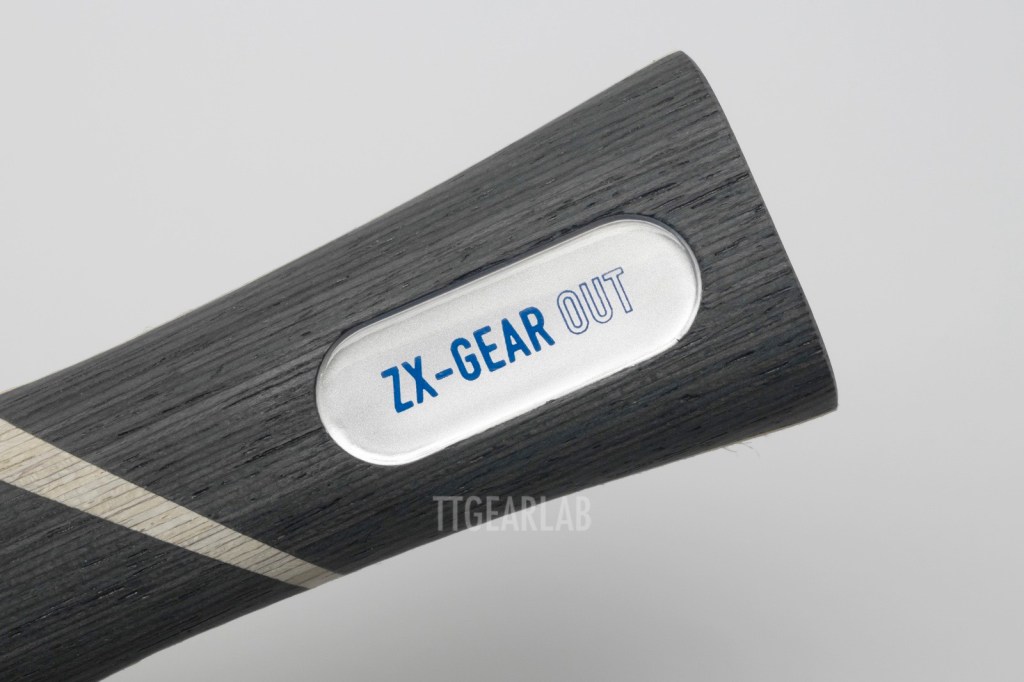
‘ZX-Gear Out’ is the outer Z carbon version of Victas ‘ZX-Gear’ series. Its primary elasticity is moderately high, and it hugs the ball very deep when the player hits the ball very strongly. Because it hugs the ball extremely deep, the player may feel that ‘ZX-Gear Out’ is somewhat slower than expected. Regarding feeling, the primary feeling of ‘ZX-Gear Out’ is softer than the feeling of ordinary outer fiber blades. On the contrary, the feeling transmitted to index finger through the wing of blade is very sharp. These characteristics are quite different from those of Butterfly blades, and close to the characteristics of Stiga outer fiber blades. It is expected that ‘ZX-Gear Out’ fits for aggressive topspin at close-to-table area. And, ‘ZX-Gear Out’ is also considerable as the blade for continuous topspin at all areas of court because its primary elasticity is sufficiently high.
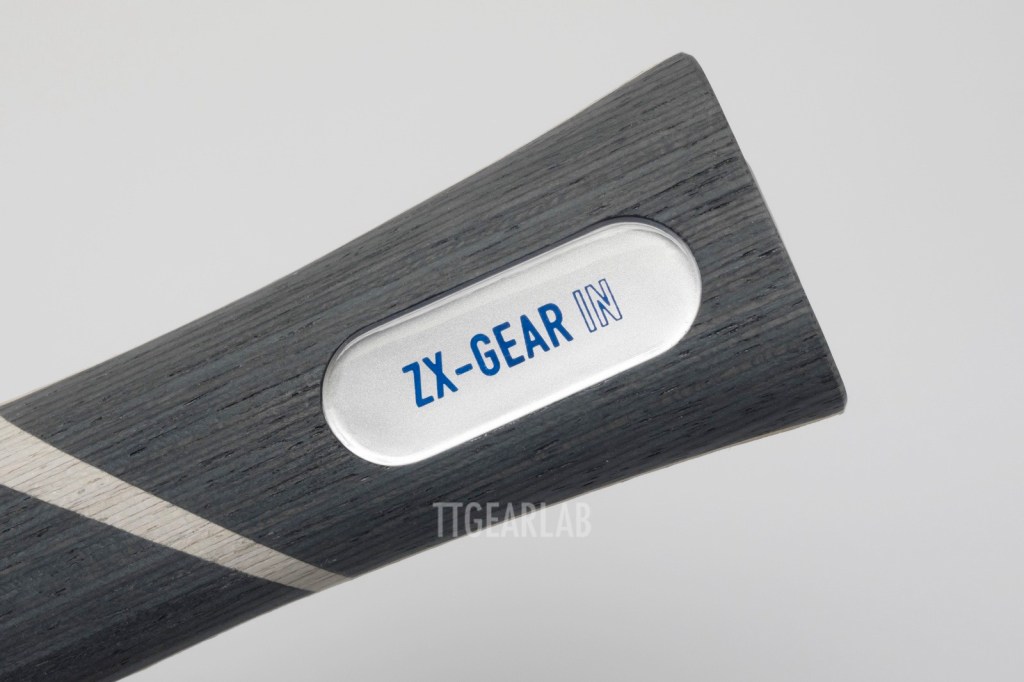
‘ZX-Gear In is the inner Z carbon version of Victas ‘ZX-Gear’ series. Its primary elasticity is somewhat high as that of inner ALC blade. But, because it hugs the ball extremely deep when the player hits the ball very strongly, the player may feel that ‘ZX-Gear In’ is somewhat slower than expected. The feeling of ‘ZX-Gear In’ is close to that of 5-ply wood offensive blade or those of softer ones among Stiga carbon blades. The overall characteristics of ‘ZX-Gear In’ are similar to those of ‘ZX-Gear Out’ with lowered elasticity and softer feeling. It is expected that ‘ZX-Gear In’ also fits for aggressive topspin at close-to-table area, but provides higher safety and stability than ‘ZX-Gear Out’. Further, because it is quite close to 5-ply wood offensive blade like ‘Korbel’, it is expected that the players who have used 5-ply wood offensive blades can easily adapt to ‘ZX-Gear In’ and enjoy enhanced power.

Both of ‘ZX-Gear Out’ and ‘ZX-Gear In’ hug the ball very deep when the impact force is high, and are soft in feeling. Because those two hugs ball deeper than the Butterfly blades with similar primary elasticity, the players who are familiar with similar type of Butterfly blades may feel that ‘ZX-Gear Out’ or ‘ZX-Gear In’ is slower. On the other hand, the player will be able to expect higher stability and better hitting feeling from ‘ZX-Gear Out’ and ‘ZX-Gear In’ when they play with aggressive topspin at close-to-table area. Especially the soft and natural feeling of ‘ZX-Gear’ series let the players who like pure wood blades easily change to fiber blades.
Please click here to return to top (table of contents)
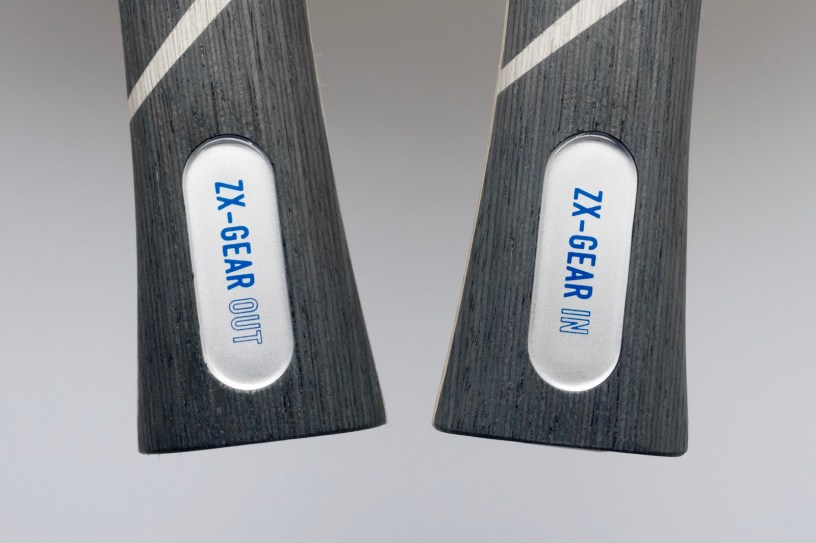
Hello,
I’d like to thank you for your invaluable work, which gives us a better idea of where we stand and a more effective and subtle approach than simply contrasting carbon outer blades with carbon inner blades or the types of wood used for the plies. My dream is that many more models will be tested. 😉
Also, as I’m concerned about the balance of the blades (I suffer with ones that are too much head-heavy), would it be possible to measure the balance point of blades, even if I’m aware that the choice of rubbers has an impact on this ?
LikeLike
Thank you for comment. At the beginning I measured also the balance point of blade. But, afterwards I stopped it because the deviation of balance point is bigger than expected, and the final balance is too much influenced by attached rubber. But, I’m considering to show also the balance point again.
LikeLike
Hello ! I don’t know if you know the two Gewo in-force pbo and s-hac, but if so, do you think that one of them could be sort of zx gear in ?
Thanks
https://tt-gewo.com/en/home/gewo-blade-in-force-pbo-pc-off#/35-handle-fl_flared
https://tt-gewo.com/en/home/gewo-blade-in-force-s-hac-off
LikeLike
I couldn’t have measured those Joola blades. But, probably the first one will be significantly different from ZX-Gear In because PBO fiber is totally different from ZX fiber. But, the second one can be compared with ZX-Gear In although we don’t know its actual characteristics yet.
LikeLike
Thanks !
LikeLike
Could you please provide the performance indices for ZX-Gear Fiber blade?
LikeLike
I have uploaded the data.
Victas ZX-Gear Fiber [Photos & Information] – TTGearLab
LikeLike
Hello,
I’m currently playing with a ZX-GEAR IN (V15 EXTRA Max Forehand / Rakza 7 Max Backhand), which I love.
Out of curiosity (because I read that the feel of hinoki blades is really fabulous…), I would like to try a hinoki blade (with or without carbon). I’ve never played with Hinoki blades before.
I don’t know if this type of blade would be suitable for my game (I like to play rather close to the table to get my opponent up to speed, alternating spinning top spins and active blocks or cushioned blocks to get my opponent off-centre and running left and right, and back and forth too). What do you think ?
Do you have a hinoki blade that you recommend (I don’t dare ask you if there’s one close to my ZX-GI as I think the sensations are totally different) ?
Thanks & Regards.
LikeLike
If the hinoki blade isn’t sufficiently thin, the close-to-table play tends to be the mixture of smash and block. Although the blades with Hinoki top layers give us fantastic feeling that the surface of blade grabs the ball, in general Hinoki blades fit more for hard hitting than continuous topspin.
So I don’t recommend Hinoki blade for the players who haven’t used Hinoki blades. We’d better consider Hinoki-surfaced blades as the blades of different world.
If you want to experience Hinoki blade, I recommend you to start with 7-ply wood blade such as Nittaku Septear, although those blades are not close to ZX-Gear In. Then you will be able to use it normally before you understand everything of Hinoki 7-ply blade.
Please note that the Ec/Ep of Hionki blades are much higher than those of ZX-Gear series. And, Vl/Vp are lower. Ec/Ep and Vl/Vp play an important role when we select blade. And, that is the main reason why we feel that Hinoki blades are the blades of another world. Of course there are some exceptions. For example Butterfly ‘Hinoki Shake’ series. But, those blades had already been discontinued.
LikeLike
Thank you for your very informative reply !
Unfortunately, I’m going to forget about the Nittaku Septear because I hate the shape of Nittaku’s flared handles.
I’ve read that the Joola Rosskopf Emotion blade has outer hinoki plies.
Do you think this blade would be a good hinoki transition from the ZX-Gear In ?
Will it have a much lower Ep than the ZX-GI for the same weight ?
Is this blade still a good choice with the plastic ball ?
Best regards.
LikeLike
Rosskopf Emotion is a good blade. But, I wonder whether we can call it as ‘Hinoki’ blade or not. Maybe it is good for transition because it is like something between non-hinoki blade and hinoki blade.
I only have lightweight pieces around 80 gram. But, its Ec is close to that of ZX-G.I. 88g. So If we hit hard, you will be able to feel similar level of speed as ZX-G.I.
Regarding the issue on plastic ball, I think that there isn’t a blade that actually doesn’t fit for plastic ball. Everything is just the issue of adjustment. And, even very slow blades can be sufficiently used with plastic ball if the players who need that characteristic try it.
Following is the Performance Indices of Joola Rosskopf Emotion (avg.weight = 79.2g) :
Ep = 1.44
Ec = 1.39 (Ec/Ep = 0.96)
Vp = 1.19
Vl = 1.19 (Vl/Vp = 1.00)
LikeLike
Thank you very much.
I heard that the Joola Rosskopf Emotion has a very low throw angle.
Is this a characteristic of the outer hinoki ply ?
Have you ever considered measuring blade’s throw angle, or would it be complicated or irrelevant ?
LikeLike
The throw angle depends on the rubber and the technic. But, the blades with high Ec/Ep tends to have lower throw angle if the player doesn’t adjust the technic and uses the same rubber.
If the player uses the rubber biased to spin performance and concentrates on dragging the ball, the throw angle will become higher. If Ec/Ep is high, the blade will respond sensitively, and that adjustment becomes somewhat difficult, but not impossible. 🙂
LikeLike
Hello,If I’ve understood correctly, two blades of the same model but with different weights (for example, a Rossi Emotion weighing 84g and a Rossi Emotion weighing 90g) will not have the same throw angle. The Ec will be the same for the two Rossi Emotion of different weights, isn’t it ?… but the 90g Rossi Emotion will have a higher Ep value… and therefore its Ec/Ep will be lower than that of the 84g. The 84g Rossi Emotion will therefore have a lower throw angle, right?
LikeLike
Not all the cases, but sometimes right.
The weight significantly affects Ec/Ep because the Ep varies more than the Ec by the difference of weight.
In many cases, lighter one has higher value of Ec/Ep. So the players who like continuous topspin will feel more comfortable with heavier ones, and feel somewhat uncomfortable with ligher once. Of course that doesn’t be a problem if the weight is not much different form the average weigh of a model. But, if the weight is just 2~3g different from the average, it will be difficult for the players to feel the difference clearly.
Please note that there can be exceptions. Especially in case there is significant variation of thickness, we can’t expect the direction that the Ec/Ep varies.
Further, if the Ec/Ep of the standard one (of average weight) is much higher than 1.0 or much lower than 1.0, the variation of Ec/Ep will not be an issue at all.
The Ec/Ep of Rossi Emotion is quite close to 1.0, and the influence of the variation of weight will be noticeable. However, probably it will be difficult to find a pc. of Rossi Emotion which is that heavy. I think that most of Rossi Emotion weigh under 85 gram.
Please also note that Rossi Emotion is the blade designed for that characteristics from the beginning. And, we can adjust by further training or selecting other rubbers. If a player fails to adjust to a blade, we can just say that that blade doesn’t fit for that player.
LikeLike
And what about the vibrations for two pieces of the same model of blade, with different weights ?
Which one will have higher Vp/Vl values ? Or will the difference be insignificant ?
Thanks, it’s a pleasure to receive all your informations.
LikeLike
The direction of the variation of vibration by the deviation of weigh is somewhat irregular. And, the values themselves don’t change significantly.
But, there is another factor that I don’t show by Performance Indices. (In fact I’m showing very simple four values those can be easily understood.) Although Vp and Vl don’t change much, the feeling becomes somewhat dry if the weight is much lower than average. And, the feeling becomes wet if the weight is much higher than average. Some players feel the dry feeling as stiffer feeling although ‘dry’ doesn’t mean ‘stiffer’ in fact.
LikeLike
Interesting, but Rossi Emotion is almost the same as Septear as we are looking only to Ec/Ep and Vl/Vp ratios. But also, there are differences in thickness and overall construction. How can you compare these two blades to each other in feeling and intend playing style? My first thought was that both of them is suited for all-round game near and mid to the table like Xiom Allround S. Also, I understand that Xiom Alround S has less speed (elasticity) and different Vl/Vp ratio that < 1,0. Also I have some experience in playing with Xiom Allround S.
LikeLike
The difference between 0.96 (Rossi Emotion) and 1.04 (Septear) is quite big difference. Of course some players who have used the blades with more extreme Ec/Ep may feel that the difference between the Ec/Ep of Rossi Emotion and that of Septear is small because those two are in ‘Near Linear’ range anyway. But, if we compare Rossi Emotion and Septear on the graph, the distance between those two is quite big.
Also, as you mentioned there are differences in thickness and overall construction. Especially thickness is important. You’ll feel that Rossi Emotion deforms more easily than Septear. (Further its Ec is much lower than that of Septear. So the center of Rossi Emotion deforms more easily.)
Regarding feeling, there isn’t big difference between Rossi Emotion and Septear, although Septear is a bit harder. Especially the important point is the the Vl/Vp’s of those two are same 1.0. Although there is difference in Ec or Ec/Ep, many players will feel that Rossi Emotion is very close to Septear.
If you don’t have the experience of thick Hinoki blades, Rossi Emotion will be easier to adapt. And, you have many experience of using thick 7-ply blades, Septear will be easier to adapt.
LikeLike
Should I reconsider my usual rubbers when I switch to a hinoki blade ?
LikeLike
It differs by player. But, in general the rubbers with harder sponge make better combination with Hinoki blades. Overall feeling may become somewhat strange if you attach the rubbers with soft sponges to Hinoki blades.
LikeLike